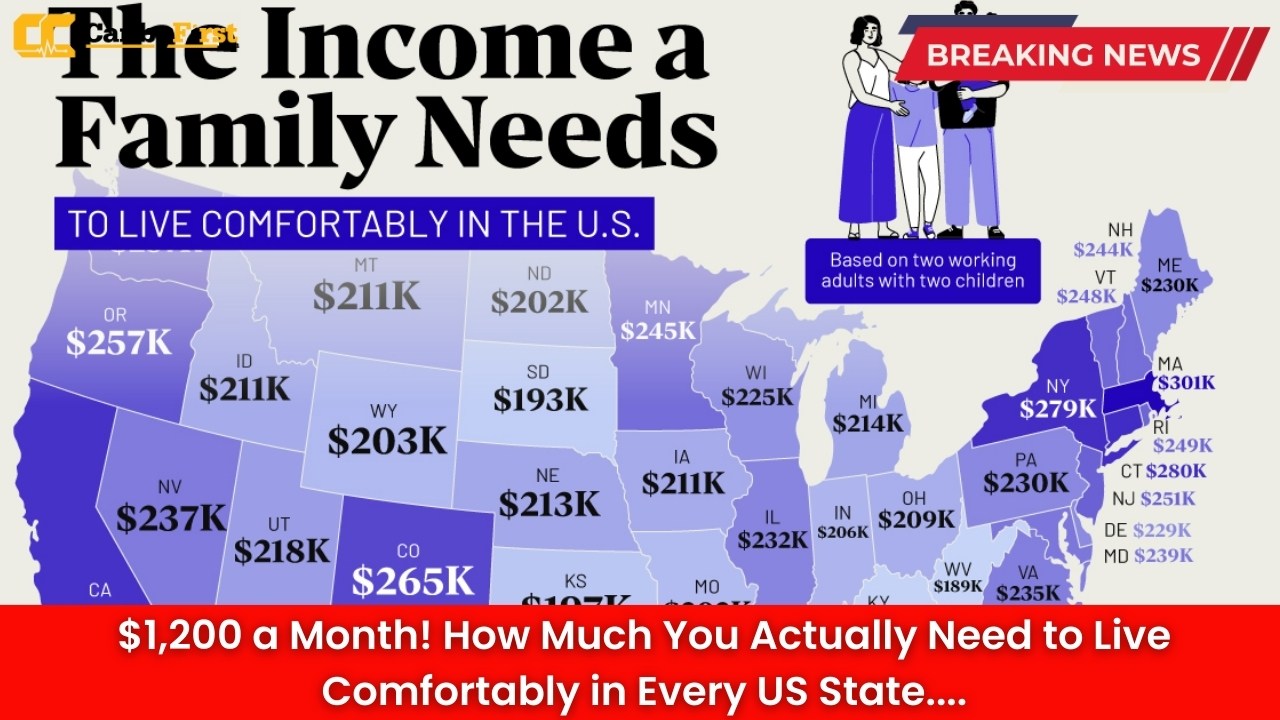New York, US: The question of how much it really takes to live comfortably in the United States has become one of the hottest debates, especially as inflation and housing prices continue to climb. A new look at data across all 50 states reveals an eye-opening reality: while $1,200 a month might stretch in some parts of the country, in others it barely covers rent. The cost of living gap between states has never been so wide, making location one of the biggest factors in determining financial comfort.
The $1,200 Question
The figure of $1,200 per month often comes up in budget challenges, retirement discussions, and cost-of-living evaluations. While the number may sound restrictive, in certain regions, it actually can cover rent, food, and basic necessities. However, in many booming urban hubs, even rent alone exceeds this threshold, leaving little room for essentials.
This disparity highlights a growing divide: what works in Mississippi or Arkansas simply isn’t feasible in New York or California.
Also Read
States Where $1,200 Goes Further
Some states still provide an affordable lifestyle for single individuals or retirees relying on fixed incomes.
-
Mississippi – Known for low housing and grocery costs, $1,200 can stretch to cover modest rent and basic living expenses in smaller towns.
-
Arkansas – Small cities here offer cheap rentals, often under $600 per month, leaving room for utilities and food.
-
West Virginia – With housing costs far below the national average, $1,200 a month can support a simple but comfortable lifestyle.
-
Oklahoma – Low energy and retail costs make day-to-day living feasible at this budget.
In these states, frugality still allows a renter to survive — and in some cases, save a little.
States Where $1,200 Falls Short
On the other end of the spectrum, certain states make living on $1,200 not only difficult but nearly impossible in major metropolitan areas.
-
New York – Median rents in New York City often exceed $3,000. Even in upstate areas, costs quickly outpace $1,200.
-
California – Whether in Los Angeles or San Francisco, rent alone can wipe out a monthly income three to four times higher than the $1,200 budget.
-
Hawaii – With some of the highest food and housing costs in America, $1,200 won’t cover basic living.
-
Massachusetts – Boston and its surrounding suburbs make this budget unrealistic, with average rents soaring well beyond $2,500.
For residents of these high-cost states, $1,200 doesn’t scratch the surface of monthly bills.
Mid-Range States
Some states fall in the middle — where $1,200 won’t allow luxury, but can still provide a workable lifestyle with careful budgeting.
-
Texas – Rural areas and small cities are far cheaper than booming hubs like Austin or Dallas.
-
Florida – Coastal cities are expensive, but inland regions still present affordable housing options close to $800-$1,000 per month.
-
Michigan – Smaller towns and suburbs have reasonable rent and grocery costs within reach of a $1,200 budget.
These are the states where the “location, location, location” rule matters most; comfort depends heavily on the choice of city or county.
Breaking Down the Essentials
Living comfortably means balancing the cost of housing, food, utilities, transportation, and healthcare. On average, housing makes up the largest chunk, usually around 30-40% of income. In high-cost areas, that percentage balloons far beyond affordability.
-
Housing: The biggest deciding factor — from $500 apartments in parts of Arkansas to $3,500 in Manhattan.
-
Groceries: Prices swing widely, with food bills notably higher in Hawaii and Alaska.
-
Utilities: States with extreme weather like Texas or Minnesota can drive electricity and heating bills upward.
-
Transportation: Car-heavy states such as Texas or Florida require reliable vehicles, while New York demands expensive public transit.
-
Healthcare: Even with insurance, medical costs vary significantly, impacting overall affordability.
Comfort vs. Survival
Experts distinguish between getting by and living comfortably. For many Americans, $1,200 allows survival: rent in a shared space, thrift groceries, and minimal extras. Living comfortably — meaning financial breathing room, savings, and discretionary spending — often requires two to three times that figure, depending on the state.
In states like Mississippi or Oklahoma, $1,200 can stretch just enough to provide balance. In New York or California, a realistic comfortable living starts closer to $4,000 to $6,000 monthly.
The Larger Picture
The discussion around $1,200 a month illustrates the broader issue of income inequality and the uneven cost of living across the United States. It also explains why so many people are moving from high-cost states to more affordable regions. Remote work has further fueled this migration, allowing workers to maintain big-city income while enjoying small-town expenses.
Frequently Asked Questions
Can you live on $1,200 a month in the US?
Yes, but only in select states and mostly rural areas. Urban centers and coastal states make this extremely difficult.
What is the cheapest state to live in?
Mississippi consistently ranks as the most affordable, with low housing and grocery costs.
Which states require the most income to live comfortably?
California, New York, Hawaii, and Massachusetts top the list with extremely high housing prices.
What income is generally needed to live comfortably in the US?
On average, around $3,000 to $5,000 per month is needed for a comfortable single lifestyle, depending on state and city.












